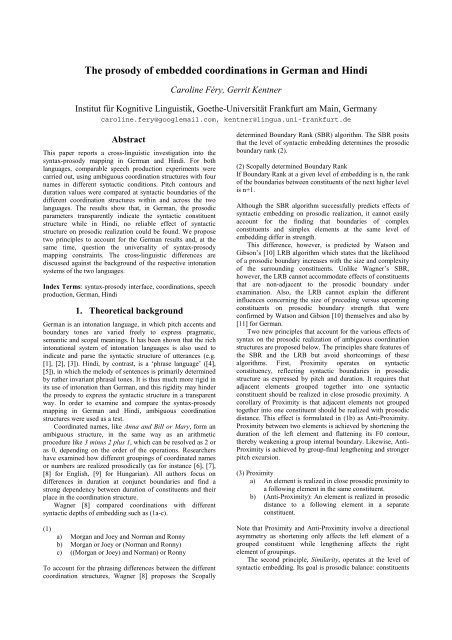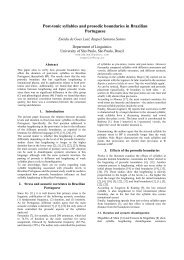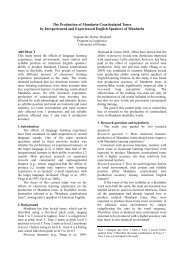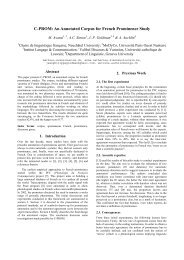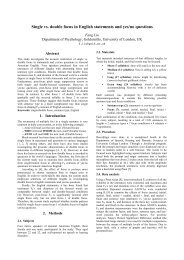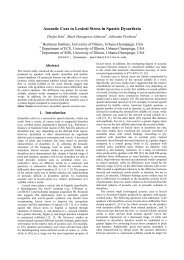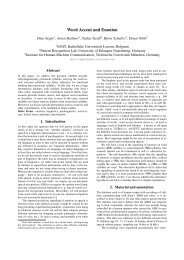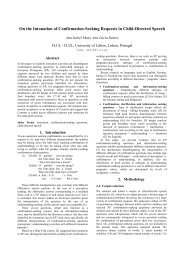The prosody of embedded coordinations in German and Hindi
The prosody of embedded coordinations in German and Hindi
The prosody of embedded coordinations in German and Hindi
Create successful ePaper yourself
Turn your PDF publications into a flip-book with our unique Google optimized e-Paper software.
<strong>The</strong> <strong>prosody</strong> <strong>of</strong> <strong>embedded</strong> <strong>coord<strong>in</strong>ations</strong> <strong>in</strong> <strong>German</strong> <strong>and</strong> H<strong>in</strong>di<br />
Carol<strong>in</strong>e Féry, Gerrit Kentner<br />
Institut für Kognitive L<strong>in</strong>guistik, Goethe-Universität Frankfurt am Ma<strong>in</strong>, <strong>German</strong>y<br />
carol<strong>in</strong>e.fery@googlemail.com, kentner@l<strong>in</strong>gua.uni-frankfurt.de<br />
Abstract<br />
This paper reports a cross-l<strong>in</strong>guistic <strong>in</strong>vestigation <strong>in</strong>to the<br />
syntax-<strong>prosody</strong> mapp<strong>in</strong>g <strong>in</strong> <strong>German</strong> <strong>and</strong> H<strong>in</strong>di. For both<br />
languages, comparable speech production experiments were<br />
carried out, us<strong>in</strong>g ambiguous coord<strong>in</strong>ation structures with four<br />
names <strong>in</strong> different syntactic conditions. Pitch contours <strong>and</strong><br />
duration values were compared at syntactic boundaries <strong>of</strong> the<br />
different coord<strong>in</strong>ation structures with<strong>in</strong> <strong>and</strong> across the two<br />
languages. <strong>The</strong> results show that, <strong>in</strong> <strong>German</strong>, the prosodic<br />
parameters transparently <strong>in</strong>dicate the syntactic constituent<br />
structure while <strong>in</strong> H<strong>in</strong>di, no reliable effect <strong>of</strong> syntactic<br />
structure on prosodic realization could be found. We propose<br />
two pr<strong>in</strong>ciples to account for the <strong>German</strong> results <strong>and</strong>, at the<br />
same time, question the universality <strong>of</strong> syntax-<strong>prosody</strong><br />
mapp<strong>in</strong>g constra<strong>in</strong>ts. <strong>The</strong> cross-l<strong>in</strong>guistic differences are<br />
discussed aga<strong>in</strong>st the background <strong>of</strong> the respective <strong>in</strong>tonation<br />
systems <strong>of</strong> the two languages.<br />
Index Terms: syntax-<strong>prosody</strong> <strong>in</strong>terface, <strong>coord<strong>in</strong>ations</strong>, speech<br />
production, <strong>German</strong>, H<strong>in</strong>di<br />
1. <strong>The</strong>oretical background<br />
<strong>German</strong> is an <strong>in</strong>tonation language, <strong>in</strong> which pitch accents <strong>and</strong><br />
boundary tones are varied freely to express pragmatic,<br />
semantic <strong>and</strong> scopal mean<strong>in</strong>gs. It has been shown that the rich<br />
<strong>in</strong>tonational system <strong>of</strong> <strong>in</strong>tonation languages is also used to<br />
<strong>in</strong>dicate <strong>and</strong> parse the syntactic structure <strong>of</strong> utterances (e.g.<br />
[1], [2], [3]). H<strong>in</strong>di, by contrast, is a ‘phrase language’ ([4],<br />
[5]), <strong>in</strong> which the melody <strong>of</strong> sentences is primarily determ<strong>in</strong>ed<br />
by rather <strong>in</strong>variant phrasal tones. It is thus much more rigid <strong>in</strong><br />
its use <strong>of</strong> <strong>in</strong>tonation than <strong>German</strong>, <strong>and</strong> this rigidity may h<strong>in</strong>der<br />
the <strong>prosody</strong> to express the syntactic structure <strong>in</strong> a transparent<br />
way. In order to exam<strong>in</strong>e <strong>and</strong> compare the syntax-<strong>prosody</strong><br />
mapp<strong>in</strong>g <strong>in</strong> <strong>German</strong> <strong>and</strong> H<strong>in</strong>di, ambiguous coord<strong>in</strong>ation<br />
structures were used as a test.<br />
Coord<strong>in</strong>ated names, like Anna <strong>and</strong> Bill or Mary, form an<br />
ambiguous structure, <strong>in</strong> the same way as an arithmetic<br />
procedure like 3 m<strong>in</strong>us 2 plus 1, which can be resolved as 2 or<br />
as 0, depend<strong>in</strong>g on the order <strong>of</strong> the operations. Researchers<br />
have exam<strong>in</strong>ed how different group<strong>in</strong>gs <strong>of</strong> coord<strong>in</strong>ated names<br />
or numbers are realized prosodically (as for <strong>in</strong>stance [6], [7],<br />
[8] for English, [9] for Hungarian). All authors focus on<br />
differences <strong>in</strong> duration at conjunct boundaries <strong>and</strong> f<strong>in</strong>d a<br />
strong dependency between duration <strong>of</strong> constituents <strong>and</strong> their<br />
place <strong>in</strong> the coord<strong>in</strong>ation structure.<br />
Wagner [8] compared <strong>coord<strong>in</strong>ations</strong> with different<br />
syntactic depths <strong>of</strong> embedd<strong>in</strong>g such as (1a-c).<br />
(1)<br />
a) Morgan <strong>and</strong> Joey <strong>and</strong> Norman <strong>and</strong> Ronny<br />
b) Morgan or Joey or (Norman <strong>and</strong> Ronny)<br />
c) ((Morgan or Joey) <strong>and</strong> Norman) or Ronny<br />
To account for the phras<strong>in</strong>g differences between the different<br />
coord<strong>in</strong>ation structures, Wagner [8] proposes the Scopally<br />
determ<strong>in</strong>ed Boundary Rank (SBR) algorithm. <strong>The</strong> SBR posits<br />
that the level <strong>of</strong> syntactic embedd<strong>in</strong>g determ<strong>in</strong>es the prosodic<br />
boundary rank (2).<br />
(2) Scopally determ<strong>in</strong>ed Boundary Rank<br />
If Boundary Rank at a given level <strong>of</strong> embedd<strong>in</strong>g is n, the rank<br />
<strong>of</strong> the boundaries between constituents <strong>of</strong> the next higher level<br />
is n+1.<br />
Although the SBR algorithm successfully predicts effects <strong>of</strong><br />
syntactic embedd<strong>in</strong>g on prosodic realization, it cannot easily<br />
account for the f<strong>in</strong>d<strong>in</strong>g that boundaries <strong>of</strong> complex<br />
constituents <strong>and</strong> simplex elements at the same level <strong>of</strong><br />
embedd<strong>in</strong>g differ <strong>in</strong> strength.<br />
This difference, however, is predicted by Watson <strong>and</strong><br />
Gibson’s [10] LRB algorithm which states that the likelihood<br />
<strong>of</strong> a prosodic boundary <strong>in</strong>creases with the size <strong>and</strong> complexity<br />
<strong>of</strong> the surround<strong>in</strong>g constituents. Unlike Wagner’s SBR,<br />
however, the LRB cannot accommodate effects <strong>of</strong> constituents<br />
that are non-adjacent to the prosodic boundary under<br />
exam<strong>in</strong>ation. Also, the LRB cannot expla<strong>in</strong> the different<br />
<strong>in</strong>fluences concern<strong>in</strong>g the size <strong>of</strong> preced<strong>in</strong>g versus upcom<strong>in</strong>g<br />
constituents on prosodic boundary strength that were<br />
confirmed by Watson <strong>and</strong> Gibson [10] themselves <strong>and</strong> also by<br />
[11] for <strong>German</strong>.<br />
Two new pr<strong>in</strong>ciples that account for the various effects <strong>of</strong><br />
syntax on the prosodic realization <strong>of</strong> ambiguous coord<strong>in</strong>ation<br />
structures are proposed below. <strong>The</strong> pr<strong>in</strong>ciples share features <strong>of</strong><br />
the SBR <strong>and</strong> the LRB but avoid shortcom<strong>in</strong>gs <strong>of</strong> these<br />
algorithms. First, Proximity operates on syntactic<br />
constituency, reflect<strong>in</strong>g syntactic boundaries <strong>in</strong> prosodic<br />
structure as expressed by pitch <strong>and</strong> duration. It requires that<br />
adjacent elements grouped together <strong>in</strong>to one syntactic<br />
constituent should be realized <strong>in</strong> close prosodic proximity. A<br />
corollary <strong>of</strong> Proximity is that adjacent elements not grouped<br />
together <strong>in</strong>to one constituent should be realized with prosodic<br />
distance. This effect is formulated <strong>in</strong> (1b) as Anti-Proximity.<br />
Proximity between two elements is achieved by shorten<strong>in</strong>g the<br />
duration <strong>of</strong> the left element <strong>and</strong> flatten<strong>in</strong>g its F0 contour,<br />
thereby weaken<strong>in</strong>g a group <strong>in</strong>ternal boundary. Likewise, Anti-<br />
Proximity is achieved by group-f<strong>in</strong>al lengthen<strong>in</strong>g <strong>and</strong> stronger<br />
pitch excursion.<br />
(3) Proximity<br />
a) An element is realized <strong>in</strong> close prosodic proximity to<br />
a follow<strong>in</strong>g element <strong>in</strong> the same constituent.<br />
b) (Anti-Proximity): An element is realized <strong>in</strong> prosodic<br />
distance to a follow<strong>in</strong>g element <strong>in</strong> a separate<br />
constituent.<br />
Note that Proximity <strong>and</strong> Anti-Proximity <strong>in</strong>volve a directional<br />
asymmetry as shorten<strong>in</strong>g only affects the left element <strong>of</strong> a<br />
grouped constituent while lengthen<strong>in</strong>g affects the right<br />
element <strong>of</strong> group<strong>in</strong>gs.<br />
<strong>The</strong> second pr<strong>in</strong>ciple, Similarity, operates at the level <strong>of</strong><br />
syntactic embedd<strong>in</strong>g. Its goal is prosodic balance: constituents
at the same level <strong>of</strong> embedd<strong>in</strong>g resemble each other <strong>in</strong><br />
prosodic structure.<br />
(4) Similarity<br />
Constituents at the same level <strong>of</strong> embedd<strong>in</strong>g have a similar<br />
prosodic realization, irrespective <strong>of</strong> the constituent’s <strong>in</strong>herent<br />
complexity.<br />
Similarity predicts prosodic adjustment <strong>of</strong> simplex elements as<br />
compared to complex constituents at the same level <strong>of</strong><br />
embedd<strong>in</strong>g. More specifically, simplex elements are<br />
lengthened to approximate the duration <strong>of</strong> the complex<br />
constituent. This also holds for simplex elements that are nonadjacent<br />
to complex constituents.<br />
As an example for the effects <strong>of</strong> Proximity <strong>and</strong> Similarity,<br />
consider the the word eggs <strong>in</strong> a sentence like Peter bought<br />
potatoes, apples, eggs, <strong>and</strong> butter compared with Peter bought<br />
potatoes, apples, eggs for pancakes, <strong>and</strong> butter. Proximity<br />
weakens a prosodic boundary after eggs <strong>in</strong> the second<br />
sentence, where it is a left element <strong>of</strong> a larger constituent. On<br />
the other h<strong>and</strong>, Anti-Proximity requires a prosodic boundary<br />
after eggs <strong>in</strong> the first sentence. Similarity dem<strong>and</strong>s lengthen<strong>in</strong>g<br />
<strong>of</strong> apples <strong>and</strong> potatoes <strong>in</strong> the second sentence compared to the<br />
first <strong>in</strong> order to adjust these words to the length <strong>of</strong> the complex<br />
constituent eggs for pancakes, yield<strong>in</strong>g a more balanced output<br />
<strong>of</strong> the list items.<br />
us<strong>in</strong>g the a C-Media Wave soundcard at a sampl<strong>in</strong>g rate <strong>of</strong><br />
44.1 kHz with 16 bit resolution.<br />
Each name <strong>and</strong> each conjunction <strong>in</strong> the set <strong>of</strong> 504 target<br />
sentences were segmented <strong>and</strong> h<strong>and</strong>-annotated by two<br />
phonetically tra<strong>in</strong>ed students <strong>and</strong> subsequently subjected to<br />
phonetic analysis us<strong>in</strong>g Praat s<strong>of</strong>tware [12]. Durations <strong>of</strong> each<br />
name (N1, N2, … <strong>in</strong> the figures) plus the follow<strong>in</strong>g pause<br />
were measured. Prior to F0 analysis, pitch was smoothed<br />
(frequency b<strong>and</strong> 10 Hz) to reduce microprosodic perturbations.<br />
<strong>The</strong> maximum F0 <strong>in</strong> the second half <strong>of</strong> the names was<br />
measured s<strong>in</strong>ce we were <strong>in</strong>terested <strong>in</strong> the scal<strong>in</strong>g <strong>of</strong> the high<br />
tones <strong>of</strong> the bitonal ris<strong>in</strong>g tones (L*H P ). F0 values were<br />
normalized tak<strong>in</strong>g the utterance wide mean F0 as the<br />
normaliz<strong>in</strong>g quotient. For all conditions, time-normalized<br />
pitch contours were created by divid<strong>in</strong>g the name <strong>in</strong>to five<br />
equal-sized <strong>in</strong>tervals <strong>and</strong> <strong>in</strong>terpolat<strong>in</strong>g the mean F0 (<strong>in</strong> Hz) <strong>of</strong><br />
these <strong>in</strong>tervals.<br />
2.1.2. Results <strong>and</strong> Discussion<br />
<strong>The</strong> structure without embedd<strong>in</strong>g <strong>in</strong> (5a) is taken as the<br />
basel<strong>in</strong>e aga<strong>in</strong>st which the other conditions are compared. <strong>The</strong><br />
results are depicted <strong>in</strong> Figure 1 <strong>and</strong> 2.<br />
2. Experiments<br />
Two speech production experiments were set up to test the<br />
predictions <strong>of</strong> Proximity <strong>and</strong> Similarity <strong>in</strong> <strong>German</strong> <strong>and</strong> H<strong>in</strong>di.<br />
2.1. <strong>German</strong><br />
2.1.1. Material <strong>and</strong> Method<br />
<strong>The</strong> material consisted <strong>in</strong> coord<strong>in</strong>ation structures with four<br />
names each, organized <strong>in</strong> six different syntactic conditions, as<br />
exemplified <strong>in</strong> (5a-f). <strong>The</strong> coord<strong>in</strong>ation und ‘<strong>and</strong>’ was used<br />
with<strong>in</strong> group<strong>in</strong>gs <strong>and</strong> the coord<strong>in</strong>ation oder ‘or’ between<br />
group<strong>in</strong>gs. Four lexically unique target sentences were created<br />
for each <strong>of</strong> the six conditions.<br />
(5)<br />
a) Suse oder N<strong>in</strong>o oder Mila oder Anna<br />
b) Suse oder N<strong>in</strong>o oder (Mila und Anna)<br />
c) (Suse und N<strong>in</strong>o) oder Mila oder Anna<br />
d) Suse oder (N<strong>in</strong>o und (Mila und Anna))<br />
e) ((Suse und N<strong>in</strong>o) und Mila) oder Anna<br />
f) (Suse und N<strong>in</strong>o) oder (Mila und Anna)<br />
All names are trochaic disyllables with as many sonorant<br />
segmental makeup as possible.<br />
For each item, a context question, spoken by a female<br />
native speaker <strong>of</strong> <strong>German</strong>, had been previously recorded. <strong>The</strong><br />
contexts were presented together with a target sentence both<br />
visually on screen <strong>and</strong> aurally over headphones. To emphasize<br />
the structure <strong>of</strong> the target sentence, it was displayed with<br />
parentheses, as <strong>in</strong> the above example. <strong>The</strong> items were<br />
presented on a 15’’ computer screen. Participants were asked<br />
to read <strong>and</strong> listen to the context <strong>and</strong> then read aloud the target<br />
sentence as an answer to the question. In case <strong>of</strong> hesitations or<br />
slips <strong>of</strong> the tongue, participants were asked to repeat the<br />
sentence. 21 female participants, all native <strong>German</strong> speakers<br />
from the Berl<strong>in</strong> area (North <strong>German</strong>y), read out the complete<br />
set <strong>of</strong> target sentences (n=24) <strong>in</strong>terspersed with numerous<br />
fillers. Record<strong>in</strong>gs took place <strong>in</strong> a sound-pro<strong>of</strong> chamber<br />
equipped with an AT4033a audio-technica studio microphone,<br />
Figure 1: Durational (upper panel) <strong>and</strong> F0 max differences<br />
(lower panel) between basel<strong>in</strong>e (0) <strong>and</strong> the other conditions on<br />
the four names. Error bars depict 95% confidence <strong>in</strong>tervals.<br />
<strong>The</strong> basel<strong>in</strong>e condition follows a regular downstep pattern (cf.<br />
Figure 2). As predicted by Proximity, left elements <strong>of</strong><br />
group<strong>in</strong>gs show less pitch excursion <strong>and</strong> are shortened to<br />
reduce the distance to a follow<strong>in</strong>g element <strong>in</strong> the same<br />
constituent (conditions c, e, f on N1; b, d, f, on N3; cf. Fig.1).<br />
Likewise, as predicted by Anti-Proximity, elements preced<strong>in</strong>g<br />
a constituent boundary are lengthened <strong>and</strong> show pitch upstep<br />
(d on N1; b, c, e, f on N2; e on N3). <strong>The</strong> second pr<strong>in</strong>ciple,<br />
Similarity, predicts lengthen<strong>in</strong>g <strong>of</strong> simplex elements if<br />
complex constituents appear at the same level <strong>of</strong> embedd<strong>in</strong>g.<br />
This prediction is also borne out (b, d on N1; b on N2; c on<br />
N3). Note that, <strong>in</strong> condition (d), Proximity <strong>and</strong> Similarity<br />
make opposite predictions for N2. Accord<strong>in</strong>g to Similarity, it<br />
should be lengthened to approximate a complex constituent<br />
which appears at the same level <strong>of</strong> embedd<strong>in</strong>g. At the same<br />
time, Proximity dem<strong>and</strong>s shorten<strong>in</strong>g <strong>of</strong> N2 <strong>in</strong> this condition, as<br />
it is a left element <strong>of</strong> a group<strong>in</strong>g. As a result, N2 shows no
clear difference to basel<strong>in</strong>e <strong>in</strong> this case, i.e. the two pr<strong>in</strong>ciples<br />
cancel each other out. On the other h<strong>and</strong>, if the pr<strong>in</strong>ciples<br />
agree <strong>in</strong> their predictions, the prosodic effect is strengthened:<br />
Compare N1 <strong>in</strong> conditions (b) <strong>and</strong> (d): While <strong>in</strong> (b), only<br />
Similarity requires lengthen<strong>in</strong>g <strong>of</strong> N1, both Similarity <strong>and</strong><br />
Anti-Proximity call for the lengthen<strong>in</strong>g <strong>in</strong> (d). As a<br />
consequence, N1 is longer <strong>and</strong> upstepped <strong>in</strong> (d) compared to<br />
(b).<br />
A difference from <strong>German</strong> was unavoidable: the coord<strong>in</strong>ated<br />
names were always followed by the postposition ke saath<br />
‘with’, as the context <strong>of</strong> the target sentence required a<br />
postpositional phrase.<br />
Disambiguat<strong>in</strong>g contexts, spoken by a male native speaker<br />
<strong>of</strong> H<strong>in</strong>di, had been previously recorded <strong>in</strong> a speech record<strong>in</strong>g<br />
lab <strong>in</strong> the University <strong>of</strong> Potsdam. <strong>The</strong> experiment was carried<br />
out <strong>in</strong> a quiet room at the University <strong>of</strong> Delhi. Devanagari<br />
script was used for contexts <strong>and</strong> target sentences. Each item<br />
was presented as follows. Participants saw a context question<br />
<strong>and</strong> its answer on a 15’’ laptop screen <strong>and</strong> simultaneously<br />
heard the question over headphones. Aga<strong>in</strong>, the target<br />
sentences were presented with parentheses. Participants were<br />
<strong>in</strong>structed to read out the target sentence as a response to the<br />
question they heard. In case <strong>of</strong> hesitation or slips <strong>of</strong> the<br />
tongue, they were asked to repeat the answer. <strong>The</strong> participants’<br />
answers were recorded on a DAT tape recorder us<strong>in</strong>g a<br />
SM10A head set microphone. 20 female native speakers <strong>of</strong><br />
H<strong>in</strong>di from the Delhi area participated <strong>in</strong> the experiment.<br />
<strong>The</strong> full set <strong>of</strong> 480 target sentences was segmented <strong>and</strong><br />
h<strong>and</strong> annotated on the word level by three phonetically tra<strong>in</strong>ed<br />
students at Potsdam University, checked by H<strong>in</strong>di native<br />
speakers <strong>and</strong> subjected to phonetic analysis.<br />
2.2.2. Results <strong>and</strong> Discussion<br />
<strong>The</strong> results <strong>of</strong> the H<strong>in</strong>di speech production experiment are<br />
depicted <strong>in</strong> Figures 3 <strong>and</strong> 4.<br />
Figure 2: Time-normalized <strong>in</strong>terpolated mean F0 tracks (<strong>in</strong><br />
Hz) <strong>of</strong> basel<strong>in</strong>e 5a (grey) plotted aga<strong>in</strong>st conditions 5b, 5c, 5d,<br />
5e <strong>and</strong> 5f (black)<br />
While Wagner’s SBR <strong>and</strong> Watson <strong>and</strong> Gibson’s LRB can<br />
account for some <strong>of</strong> the effects found here, they fail to predict<br />
prosodic effects <strong>in</strong> critical conditions. <strong>The</strong> LRB, for example,<br />
cannot expla<strong>in</strong> the longer duration <strong>of</strong> N1 <strong>in</strong> condition (b) that<br />
is predicted by Similarity. <strong>The</strong> SBR fails to predict the<br />
shorten<strong>in</strong>g <strong>of</strong> N1 <strong>in</strong> conditions (c), (e) <strong>and</strong> (f), or <strong>of</strong> N3 <strong>in</strong> (b),<br />
(d), (f) which is straightforwardly derived from Proximity.<br />
2.2. H<strong>in</strong>di<br />
2.2.1. Material <strong>and</strong> Method<br />
In H<strong>in</strong>di, as well, four lexically unique coord<strong>in</strong>ation structures<br />
with usual names were devised. <strong>The</strong> sentences appear <strong>in</strong> the<br />
same six syntactic conditions as <strong>in</strong> <strong>German</strong> (see (5)); the<br />
<strong>coord<strong>in</strong>ations</strong> aur ‘<strong>and</strong>’ <strong>and</strong> yaa ‘or’ were used with<strong>in</strong> <strong>and</strong><br />
outside <strong>of</strong> the group<strong>in</strong>gs respectively. An example is given <strong>in</strong><br />
(6).<br />
(6) (viral aur vaaman) yaa (yaman aur yogi) ke saath<br />
Viral <strong>and</strong> Vaaman or Yaman <strong>and</strong> Yogi with<br />
‘With Viral <strong>and</strong> Vaaman or Yaman <strong>and</strong> Yogi’<br />
Figure 3: Durational (upper panel) <strong>and</strong> F0 differences (lower<br />
panel) between basel<strong>in</strong>e (0) <strong>and</strong> other conditions on the four<br />
names. Error bars depict 95% confidence <strong>in</strong>tervals.<br />
No reliable differences between the conditions were found<br />
with respect to F0 (cf. lower panel <strong>of</strong> Figure 3). Quite to the<br />
contrary, the F0-patterns <strong>of</strong> the six conditions show a strik<strong>in</strong>g<br />
similarity with ris<strong>in</strong>g pitch on each name irrespective <strong>of</strong> its<br />
syntactic status <strong>in</strong> the coord<strong>in</strong>ation structure (see Figure 4).<br />
Also, the durational values lack the differentiation that was<br />
found <strong>in</strong> the <strong>German</strong> experiment (see upper panel <strong>of</strong> Figure 3).<br />
<strong>The</strong> only pattern that shows a significant difference is<br />
condition (e), <strong>in</strong> which N2 <strong>and</strong> N3 are lengthened compared to<br />
basel<strong>in</strong>e. We cannot exclude that this effect is owed to general<br />
process<strong>in</strong>g difficulties with this condition rather than reflection<br />
<strong>of</strong> syntactic structure. Given the lack <strong>of</strong> further significant
effects, neither the predictions derived from the pr<strong>in</strong>ciples<br />
Proximity <strong>and</strong> Similarity nor the SBR or LRB can expla<strong>in</strong> the<br />
H<strong>in</strong>di <strong>prosody</strong> which seems to be largely <strong>in</strong>sensitive to the<br />
structural differences. <strong>The</strong> lack <strong>of</strong> syntactic effects on prosodic<br />
structure agrees with results obta<strong>in</strong>ed from a comparative<br />
study on <strong>prosody</strong> <strong>in</strong> relative clause constructions <strong>in</strong> <strong>German</strong><br />
<strong>and</strong> H<strong>in</strong>di [15].<br />
Figure 4: Time-normalized <strong>and</strong> <strong>in</strong>terpolated mean F0 tracks<br />
(<strong>in</strong> Hz) <strong>of</strong> the six conditions.<br />
3. Conclusions<br />
<strong>The</strong> results for <strong>German</strong> show that prosodic structure reflects<br />
syntactic group<strong>in</strong>g <strong>and</strong> embedd<strong>in</strong>g <strong>in</strong> a precise way, both for<br />
duration <strong>and</strong> for pitch. Proximity <strong>and</strong> Similarity account for<br />
the prosodic structure emerg<strong>in</strong>g from the syntactic structure.<br />
<strong>The</strong> first pr<strong>in</strong>ciple, Proximity, accounts for the lower pitch <strong>and</strong><br />
shorter duration observed on the left member <strong>of</strong> group<strong>in</strong>gs. Its<br />
corollary, Anti-Proximity, has the opposite effect <strong>and</strong><br />
strengthens the boundary between two constituents by<br />
lengthen<strong>in</strong>g the right member <strong>of</strong> group<strong>in</strong>gs. <strong>The</strong> second<br />
pr<strong>in</strong>ciple, Similarity, accounts for the observation that simplex<br />
elements <strong>in</strong> an expression conta<strong>in</strong><strong>in</strong>g group<strong>in</strong>gs have <strong>in</strong>creased<br />
duration <strong>and</strong> higher pitch to achieve similar <strong>prosody</strong> to<br />
complex elements at the same level <strong>of</strong> syntactic embedd<strong>in</strong>g.<br />
As a result, <strong>German</strong> uses <strong>prosody</strong> <strong>in</strong> a sensitive way,<br />
<strong>in</strong>terpret<strong>in</strong>g syntactic structure with exactitude. This property<br />
<strong>of</strong> <strong>German</strong> correlates with its general <strong>in</strong>tonational system.<br />
<strong>German</strong>, as an <strong>in</strong>tonation language, is able to change pitch<br />
accents <strong>and</strong> boundary tones <strong>in</strong> a variety <strong>of</strong> ways to express<br />
pragmatic mean<strong>in</strong>gs. Pitch scal<strong>in</strong>g is a f<strong>in</strong>e-gra<strong>in</strong>ed device<br />
which supports this use <strong>of</strong> <strong>in</strong>tonation, as shown <strong>in</strong> [13]. Our<br />
experiment demonstrates that <strong>prosody</strong> as a whole supports the<br />
rendition <strong>of</strong> syntactic structure.<br />
H<strong>in</strong>di, by contrast, shows a surpris<strong>in</strong>g lack <strong>of</strong> correlation<br />
between syntactic structure <strong>and</strong> <strong>prosody</strong>, see also [15] for<br />
similar results. Neither Proximity nor Similarity were<br />
supported by the H<strong>in</strong>di data. Also, neither SBR nor LRB are<br />
able to make the correct predictions for H<strong>in</strong>di. <strong>The</strong>se results<br />
can only be understood when H<strong>in</strong>di <strong>in</strong>tonation is considered as<br />
a whole. H<strong>in</strong>di is a phrase language, accord<strong>in</strong>g to the sentencebased<br />
typology <strong>of</strong> <strong>in</strong>tonational systems, see [4]. <strong>The</strong> melody <strong>of</strong><br />
sentences arise primarily because <strong>of</strong> the distribution <strong>of</strong> phrasal<br />
tones which are, as the name <strong>of</strong> these tones <strong>in</strong>dicates, assigned<br />
at the level <strong>of</strong> the prosodic phrases, <strong>and</strong> not because <strong>of</strong> pitch<br />
accents. High tones <strong>in</strong> a syntactically simple H<strong>in</strong>di sentence<br />
are always <strong>in</strong> a downstep relation, <strong>and</strong> are only marg<strong>in</strong>ally<br />
sensitive to <strong>in</strong>formation structure (see [5]).<br />
<strong>The</strong> results <strong>of</strong> these two experiments have several<br />
implications for theoretical considerations about the role <strong>of</strong><br />
<strong>prosody</strong> <strong>in</strong> reflect<strong>in</strong>g syntax. Clearly it seems that the prosodic<br />
reflection <strong>of</strong> syntactic <strong>and</strong> or semantic structure is not a<br />
universal property as has been suggested by [14] for the<br />
parameter <strong>of</strong> duration. Instead, whether <strong>and</strong> to what extent<br />
syntactic relations are reflected <strong>in</strong> prosodic structure crucially<br />
depends on the language. <strong>The</strong> apparent lack <strong>of</strong> prosodic<br />
mark<strong>in</strong>g <strong>of</strong> syntactic group<strong>in</strong>g <strong>in</strong> H<strong>in</strong>di might be the cost for<br />
the clear <strong>and</strong> consistent mark<strong>in</strong>g <strong>of</strong> prosodic phrases, which<br />
might not adjust to pragmatic conditions <strong>in</strong> the same way as <strong>in</strong><br />
<strong>German</strong>. More research is needed to confirm this hypothesis.<br />
<strong>The</strong> difference between the two languages is important for<br />
underst<strong>and</strong><strong>in</strong>g the role that <strong>prosody</strong> plays <strong>in</strong> language<br />
comprehension. Languages may differ <strong>in</strong> this dimension much<br />
more than assumed until now. <strong>The</strong> research on the role <strong>of</strong><br />
<strong>prosody</strong> on speech process<strong>in</strong>g has largely concentrated on<br />
<strong>in</strong>tonation languages, which do use pitch changes <strong>and</strong> pitch<br />
scal<strong>in</strong>g for the communication <strong>of</strong> syntax <strong>and</strong> semantics, <strong>and</strong><br />
has <strong>of</strong>ten ignored other types <strong>of</strong> languages, such as those<br />
which rely more on phras<strong>in</strong>g for this parameter. We hope to<br />
have revealed the need for well-designed experiments for<br />
elucidat<strong>in</strong>g this issue.<br />
4. Acknowledgements<br />
This paper is part <strong>of</strong> the DFG funded project Prosody <strong>in</strong><br />
Pars<strong>in</strong>g. Thanks to Shravan Vasishth, Frank Kügler <strong>and</strong> to two<br />
anonymous reviewers for helpful comments. Many thanks are<br />
due to Umesh Patil who prepared the H<strong>in</strong>di material <strong>and</strong> who<br />
ran the production experiment <strong>in</strong> Delhi, as well as to Carol<strong>in</strong>e<br />
Magister <strong>and</strong> Verena Thießen who ran the <strong>German</strong><br />
experiment. We are grateful to Daniel Quernheim, for<br />
technical assistance.<br />
5. References<br />
[1] Frazier, L., Carlson, K., Clifton, C., “Prosodic phras<strong>in</strong>g is central<br />
to language comprehension”, Trends <strong>in</strong> Cognitive Sciences 10<br />
(6), 244-249, 2006.<br />
[2] Schafer, A., Speer, S., Warren, P., White SD., “Intonational<br />
Disambiguation <strong>in</strong> Sentence Production <strong>and</strong> Comprehension”,<br />
Journal <strong>of</strong> Psychol<strong>in</strong>guistic Research 29 (2), 169-182, 2000.<br />
[3] Carlson, K., “<strong>The</strong> Effects <strong>of</strong> Parallelism <strong>and</strong> Prosody <strong>in</strong> the<br />
Process<strong>in</strong>g <strong>of</strong> Gapp<strong>in</strong>g Structures”, Language <strong>and</strong> Speech 43 (3),<br />
229-259, 2001.<br />
[4] Féry, C., “Indian languages as <strong>in</strong>tonational ‘phrase languages’”,<br />
<strong>in</strong> I. Hasna<strong>in</strong> <strong>and</strong> S. Chaudhury [Eds] Festschrift to honour<br />
Ramakant Agnihotri, Aakar Publisher, Delhi. 2010.<br />
[5] Patil, U., Kentner, G., Gollrad, A., Kügler, F., Féry, C. <strong>and</strong><br />
Vasishth, S., “Focus, word order <strong>and</strong> <strong>in</strong>tonation <strong>in</strong> H<strong>in</strong>di”,<br />
Journal <strong>of</strong> South Asian L<strong>in</strong>guistics 1, 55-72, 2008.<br />
[6] Lehiste, I., “<strong>The</strong> many l<strong>in</strong>guistic functions <strong>of</strong> duration.” Zürich:<br />
Symposium Prosody. 1983.<br />
[7] Ladd, D.R.., “Intonational phras<strong>in</strong>g: the case for recursive<br />
prosodic structure”, Phonology Yearbook 3, 311-140, 1986.<br />
[8] Wagner, M., “Prosody <strong>and</strong> recursion”, Doctoral Dissertation,<br />
Massachusetts Institute <strong>of</strong> Technology, Cambridge, Mass., 2005.<br />
[9] Hunyadi, L., “Group<strong>in</strong>g, the cognitive basis for recursion <strong>in</strong><br />
language”, Argumentum 2, 67-114, 2006.<br />
[10] Watson, D. <strong>and</strong> Gibson, E., “<strong>The</strong> relationship between<br />
<strong>in</strong>tonational phras<strong>in</strong>g <strong>and</strong> syntactic structure <strong>in</strong> language<br />
production”, Language <strong>and</strong> Cognitive Processes 19/6, 713-755,<br />
2004.<br />
[11] Kentner, G., “Length, order<strong>in</strong>g preferences <strong>and</strong> <strong>in</strong>tonational<br />
phras<strong>in</strong>g: Evidence from pauses”, Proceed<strong>in</strong>gs <strong>of</strong> Interspeech,<br />
2337-2340, 2007.<br />
[12] Boersma, P. <strong>and</strong> Ween<strong>in</strong>k, D., “PRAAT - do<strong>in</strong>g phonetics by<br />
computer”, Onl<strong>in</strong>e resource: http://www.praat.org, 1997-2009.<br />
[13] Féry, C. <strong>and</strong> Kügler, F., “Pitch accent scal<strong>in</strong>g on given, new, <strong>and</strong><br />
focused constituents <strong>in</strong> <strong>German</strong>”, Journal <strong>of</strong> Phonetics 36(4),<br />
680-703, 2008.<br />
[14] Yang, Li-chiung. “Duration <strong>and</strong> pauses as boundary markers <strong>in</strong><br />
speech: a cross-l<strong>in</strong>guistic study”, Proceed<strong>in</strong>gs <strong>of</strong> Interspeech,<br />
458-461, 2007.<br />
[15] Féry, C. <strong>and</strong> Schubö, F., “Hierarchical structures <strong>in</strong> the <strong>in</strong>tonation<br />
<strong>of</strong> recursive sentences”, Submitted. Potsdam. 2010.


